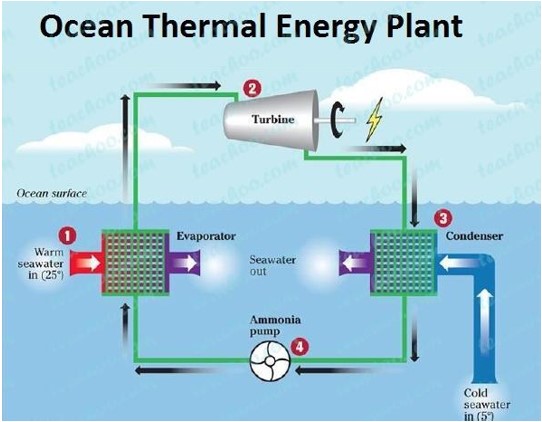- Definition and Types of Energy
- Myths And Misconceptions About Energy
- The Relationship Between Energy and Environment
- Climate Change and Carbon Footprint
- Greenhouse Gas Effect
- The Role of Human-Induced Greenhouse Gases and Energy Consumption
- Energy Efficiency and Sustainability
- Renewable Energy Sources and Future Perspectives
- Play and Learn
- Solar Energy Conversions
- Solar Energy Worldwide
- Solar Energy in Partner Countries
- Positive and Negative Impacts
- Technologies for Harnessing Solar Energy
- Solar thermal energy technologies and applications
- Electricity Generation Methods
- Passive Heating and Cooling of Residences with the Sun
- Concentrator solar power (CSP) systems and electricity generation
- Systems and Applications That Generate Electricity directly from solar rays
- Photovoltaic Cells and Panels
- Domestic PV Systems
- Off-Grid PV Systems
- Hybrid Connected Systems
- Materials Used in PV Cells
- Play and Learn
 Ocean Thermal Energy
Ocean Thermal Energy

The Ocean Thermal Energy Conversion (OTEC) system is a method that aims to generate electricity from the temperature difference between the ocean surface and its depths. This concept was described by the French biophysicist Jacques Arsène d’Arsonval in 1881.
How Does It work ?
Hot water from the ocean surface is used to vaporize a liquid with a low boiling point (such as ammonia).
The steam turns a turbine to produce electricity.
This steam is then condensed using the cold deep waters of the ocean and the system is turned back on.
- Closed Loop OTEC
- A liquid with a low boiling point (for example, ammonia) is used.
- The hot water vaporizes this liquid, turning the turbines and producing energy.
- The liquid is then re-condensed with cold deep water, continuing the system.
- Open Loop OTEC
- Hot water on the ocean surface is taken directly to a low-pressure area and vaporized.
- The steam turns a turbine, producing electricity.
- It is then condensed by cold water and returned to liquid form.
- Hybrid OTEC:
- It is a combination of closed and open loop systems.
- The advantages of both methods are used to increase efficiency.
OTEC is an environmentally friendly and sustainable energy source. However, the system is expensive to install and can only be applied in tropical ocean regions where the temperature difference is significant.